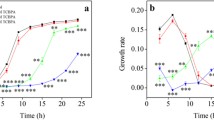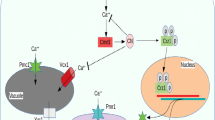Abstract
The present work has as objective to contribute for the elucidation of the mechanism associated with Pb detoxification, using the yeast Saccharomyces cerevisiae as a model organism. The deletion of GTT1 or GTT2 genes, coding for functional glutathione transferases (GST) enzymes in S. cerevisiae, caused an increased susceptibility to high Pb concentrations (500–1000 μmol L−1). These results suggest that the formation of glutathione-Pb conjugate (GS-Pb), dependent of GSTs, is important in Pb detoxification. The involvement of ATP-binding cassette (ABC) vacuolar transporters, belonging to class C subfamily (ABCC) in vacuolar compartmentalization of Pb, was evaluated. For this purpose, mutant strains disrupted in YCF1, VMR1, YBT1 or BPT 1 genes were used. All mutants tested, without vacuolar ABCC transporters, presented an increased sensitivity to 500–1000 μmol L−1 Pb comparative to wild-type strain. Taken together, the obtained results suggest that Pb detoxification, by vacuolar compartmentalization, can occur as a result of the concerted action of GSTs and vacuolar ABCC transporters. Pb is conjugated with glutathione, catalysed by glutathione transferases and followed to the transport of GS-Pb conjugate to the vacuole by ABCC transporters.



Similar content being viewed by others
References
ATSDR (2007). Toxicological profile for lead, Agency for Toxic Substances and Disease Registry (ATSDR). U.S. Department of Health and Human Services—Public Health Service.
Rossi, E. (2008). Clinical Biochemistry Reviews, 29, 63–70.
Avery, S. V. (2011). Biochemistry Journal, 434, 201–210.
Soares, E. V., Duarte, A. P. S. R., Boaventura, R. A., & Soares, H. M. V. M. (2002). Applied Microbiology and Biotechnology, 58, 836–841.
Soares, E. V., Hebbelinck, K., & Soares, H. M. V. M. (2003). Canadian Journal of Microbiology, 49, 336–343.
Bussche, J. V., & Soares, E. V. (2011). Applied Microbiology and Biotechnology, 90, 679–687.
Yuan, X. F., & Tang, C. C. (1999). Journal of Environmental Science and Health Part A-Toxic/Hazardous Substances & Environmental Engineering, 34, 1117–1128.
Yu, S. S., Qin, W., Zhuang, G. Q., Zhang, X. E., Chen, G. J., & Liu, W. F. (2009). Current Microbiology, 58, 504–510.
Cui, Q. H., & Tang, C. C. (2000). Environmental Science Health Part A-Toxic/Hazardous Substance Environmental Engineering, 35, 1663–1671.
Perez, R. R., Sousa, C. A., Vankeersbilck, T., Machado, M. D., & Soares, E. V. (2013). Current Microbiology, 67, 300–305.
Wysocki, R., & Tamás, M. J. (2010). FEMS Microbiology Reviews, 34, 925–951.
Avery, S. V. (2001). Advances in Applied Microbiology, 49, 111–142.
Ramsay, L. M., & Gadd, G. M. (1997). FEMS Microbiology Letters, 152, 293–298.
Sousa, C. A., Perez, R. R., & Soares, E. V. (2014). Current Microbiology, 68, 113–119.
Li, Z. S., Lu, Y. P., Zhen, R. G., Szczypka, M., Thiele, D. J., & Rea, P. A. (1997). Proceedings of the National Academy of Sciences of the United States of America, 94, 42–47.
Szczypka, M. S., Wemmie, J. A., Moyerowley, W. S., & Thiele, D. J. (1994). Journal of Biological Chemistry, 269, 22853–22857.
Gueldry, O., Lazard, M., Delort, F., Dauplais, M., Grigoras, I., Blanquet, S., & Plateau, P. (2003). European Journal of Biochemistry, 270, 2486–2496.
Choi, J. H., Lou, W., & Vancura, A. (1998). Journal of Biological Chemistry, 273, 29915–29922.
Paumi, C. M., Chuk, M., Snider, J., Stagljar, I., & Michaelis, S. (2009). Microbiology and Molecular Biology Reviews, 73, 577–593.
Wawrzycka, D., Sobczak, I., Bartosz, G., Bocer, T., Ulaszewski, S., & Goffeau, A. (2010). FEMS Yeast Research, 10, 828–838.
Petrovic, S., Pascolo, L., Gallo, R., Cupelli, F., Ostrow, J. D., Goffeau, A., Tiribelli, C., & Bruschi, C. V. (2000). Yeast, 16, 561–571.
Ortiz, D. F., StPierre, M. V., Abdulmessih, A., & Arias, I. M. (1997). Journal of Biological Chemistry, 272, 15358–15365.
Sasser, T. L., Padolina, M., & Fratti, R. A. (2012). Biochemical Journal, 448, 365–372.
Mason, D. L., Mallampalli, M. P., Huyer, G., & Michaelis, S. (2003). Eukaryotic Cell, 2, 588–598.
Li, Z. S., Szczypka, M., Lu, Y. P., Thiele, D. J., & Rea, P. A. (1996). Journal of Biological Chemistry, 271, 6509–6517.
Haugland, R. P. (2005). The handbook—a guide to fluorescent probes and labeling technologies, 10th edition. Eugene, OR, USA: Invitrogen Corp.
Board, P. G., & Menon, D. (2013). Biochimica et Biophysica Acta-General Subjects, 1830, 3267–3288.
Adamis, P. D. B., Gomes, D. S., Pinto, M., Panek, A. D., & Eleutherio, E. C. A. (2004). Toxicology Letters, 154, 81–88.
Sharma, K. G., Mason, D. L., Liu, G. S., Rea, P. A., Bachhawat, A. K., & Michaelis, S. (2002). Eukaryotic Cell, 1, 391–400.
Ghosh, M., Shen, J., & Rosen, B. P. (1999). Proceedings of the National Academy of Sciences of the United States of America, 96, 5001–5006.
Song, W. Y., Sohn, E. J., Martinoia, E., Lee, Y. J., Yang, Y. Y., Jasinski, M., Forestier, C., Hwang, I., & Lee, Y. (2003). Nature Biotechnology, 21, 914–919.
Prévéral, S., Ansoborlo, E., Mari, S., Vavasseur, A., & Forestier, C. (2006). Biochimie, 88, 1651–1663.
Soares, H. M. V. M., Conde, P. C. F. L., Almeida, A. A. N., & Vasconcelos, M. T. S. D. (1999). Analytica Chimica Acta, 394, 325–335.
Soares, E. V., Duarte, A., & Soares, H. (2000). Chemical Speciation and Bioavailability, 12, 59–65.
Acknowledgments
The authors thank the FCT Strategic Project PEst-OE/EQB/LA0023/2013.
Author information
Authors and Affiliations
Corresponding author
Rights and permissions
About this article
Cite this article
Sousa, C.A., Hanselaer, S. & Soares, E.V. ABCC Subfamily Vacuolar Transporters are Involved in Pb (Lead) Detoxification in Saccharomyces cerevisiae . Appl Biochem Biotechnol 175, 65–74 (2015). https://doi.org/10.1007/s12010-014-1252-0
Received:
Accepted:
Published:
Issue Date:
DOI: https://doi.org/10.1007/s12010-014-1252-0




